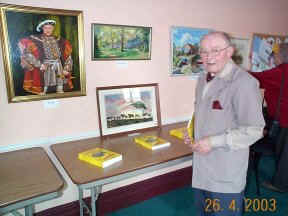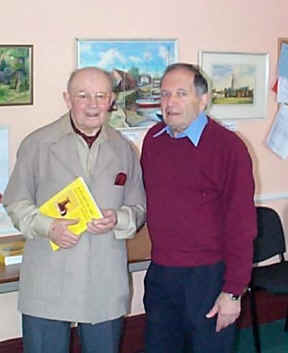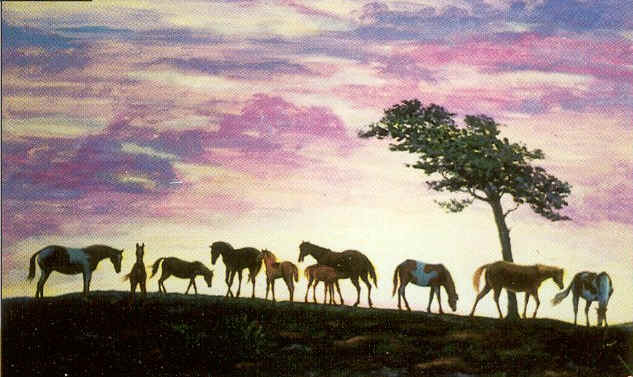
The article A Start in Art, and the book review that follows it, were both taken from Issue No. 6 of the on line edition of Nurturing Potential.
A Start in Art
by Joe Sinclair

His letter is before me as I type this. It is dated September 1, 2001 and starts:
Dear Joseph, My wife Winifred and I were delighted to meet you yesterday and to have the preliminary chat regarding the possibility of producing a book.
It concludes:
I will send you a brief summary of the book I have in mind and then await your reaction before I proceed further.
It was signed:
Alan Crowe.
At that time Alan was already well into his eighties.
Last week I attended the book launch in New Milton, Hampshire, of the book that had progressed from Alan's mind through the various stages of discussion, anguish, disappointment, and much hard work (particularly on Alan's part), before ending up as the attractively printed and artistically designed work that is reviewed in our book pages. [You can read the review below] The picture above shows an ecstatic Alan Crowe. He may not look ecstatic to you. As he wrote in another one of his handwritten letters, this one dated February 13, 2003 "You say I must be getting very excited. Well I suppose so, but it is a restrained excitement." So he doesn't reveal his feelings very much, but I know that inside he is ecstatic.
And why not? At any age it is a considerable accomplishment to go from the germ of an idea for a book to the completion of the project. When that achievement involves not merely the writing of the text, but the producing of the graphics in a work that is graphically top-heavy, finding a suitable printing company that can also offer help on the production and marketing side, and then taking total responsibility for the financing, publishing and distribution, this is an achievement of which anyone, at any age, can be justifiably proud. Let alone someone in their mid-eighties.
But Alan has kept himself active and involved for more than seventy years. His background was in advertising, mainly copywriting, but his interest in art also started then and was indulged at every opportunity. He had, many years earlier, and long before retiring to the south coast, produced a book of drawings and narrative of old taverns and public houses in Surrey. He had also started drawing illustrated regional maps and selling them through local outlets. He has continued this activity, and his maps of New Milton and Barton-on-Sea are on sale in several local newsagents shops.
Alan's letter to me in September 2001 was the result of his having seen an article about me and my ASPEN self-publishing service in the Prime Time supplement to Dorset's Daily Echo of August 2001. The article described how I was targeting "senior citizens", primarily via the University of the Third Age; encouraging them to consider writing "the book that is within every one of us" and learning how to publish it themselves. I had produced a booklet called Publishing Your Book, and Alan had written asking for a copy.
The service offered by ASPEN is non profit-making. It aims to recover costs out of book sale proceeds if the book is eventually published and sold. It is as much a retirement hobby as anything for me; a lot cheaper than philately; and a lot more fun than examining watermarks. My satisfaction, my personal sense of achievement, comes from the success of my clients.
When Alan's book was printed I wrote to tell him that I regarded him as one of my greatest success stories. He wrote back: "I take [that statement] with a pinch of salt. You must reserve judgement until we see if I sell any copies of the book!"
A typically self-effacing comment. I think the book will sell very well. But whether it does or not, it is a success, and Alan is a success, and I am proud to be associated with it.

Alan Crowe with Joe Sinclair at the book launch
A Start in Art, by Alan Crowe. Seacroft Books, 126 pp (including copious black and white graphics throughout and a 12-page colour centrefold, £10.50. ISBN 0-954446-70-4
I have to declare my partiality . . . and my pride . . . as well as my small contribution to the publication of this book. I hope that the review itself, and my delight in its appearance and excellent content, will nevertheless be sufficiently impartial. My partiality derives from my involvement with the author from the book's beginnings as a potential project, through several meetings when (wearing my ASPEN hat) we thrashed out ways and means of bringing the project to fruition, to the moment when I left Alan to his own devices and the exploration of ways and means of having the book published and printed. I like to feel that his success in carrying the project through to completion was in at least some small measure the result of "empowerment" by ASPEN, as promised in our publicity. I'm also delighted that he chose to adopt my suggested title for the book.
Having declared the partiality, let me now describe the book.
Alan Crowe has a singular advantage. Commonly, "how-to" books are written by experts in their chosen field for the use of novices. It is not, therefore, altogether uncommon for a slippage to appear between the ability of the writer to convey knowledge comprehensibly, and the ability of the reader to follow the instructions intelligently. Alan Crowe is not merely an expert in the field of graphic design, draftsmanship, and the practice of every type and medium of art over a period of more than 70 years, but he is a writer who is able to express what he has done (and what others should do) in a lucid, simple and easily understandable way.
And the book is not merely comprehensible, it is also remarkably comprehensive for a work of a mere 126 pages. Furthermore Alan's lavish illustration with so many of his own wonderfully evocative works - many of them revealing his delight in and love of his local New Forest flora and fauna - alone would be "worth the price of admission".

New Forest ponies is one of the book's illustrations
It is always a pleasure to see a craftsman at work and, in the way the book has been laid out and so lovingly crafted, the intention of the writer to convey his feelings of pleasure at the hobby of painting and drawing, particularly for those who have retired and are looking for a satisfying way of spending their new-found leisure time, has been wonderfully fulfilled.
From "Those first bold strokes", through the use of "Tools, time and Space", with a few meanders in the direction of "How to Copy", where to find your subjects, how to frame and hang, he ends up with a flourish on how to file, sell and otherwise dispose of your completed works. And having seen the "miles" of corridor wall covered with his paintings in his retirement home, this is no small concern.
So exciting a read was it, that I would be sorely tempted to take up Art myself, were I not already so heavily engaged in producing this magazine!
Joe Sinclair